Forensic Recovery

Computer forensics (sometimes known as computer forensic science) is a branch of digital forensic science pertaining to legal evidence found in computers and digital storage media. The goal of computer forensics is to examine digital media in a forensically sound manner with the aim of identifying, preserving, recovering, analyzing and presenting facts and opinions about the digital information.
Although it is most often associated with the investigation of a wide variety of computer crime, computer forensics may also be used in civil proceedings. The discipline involves similar techniques and principles to data recovery, but with additional guidelines and practices designed to create a legal audit trail.
Evidence from computer forensics investigations is usually subjected to the same guidelines and practices of other digital evidence. It has been used in a number of high-profile cases and is becoming widely accepted as reliable within U.S. and European court systems.
Forensic process
A portable Tableau write blocker attached to a Hard Drive
Computer forensic investigations usually follow the standard digital forensic process (acquisition, analysis and reporting).[7] Investigations are performed on static data (i.e. acquired images) rather than “live” systems. This is a change from early forensic practices where a lack of specialist tools led to investigators commonly working on live data.
Techniques
A number of techniques are used during computer forensics investigations.
- Cross-drive analysis
- A forensic technique that correlates information found on multiple hard drives. The process, still being researched, can be used to identify social networks and to perform anomaly detection.
- Live analysis
- The examination of computers from within the operating system using custom forensics or existing sysadmin tools to extract evidence. The practice is useful when dealing with Encrypting File Systems, for example, where the encryption keys may be collected and, in some instances, the logical hard drive volume may be imaged (known as a live acquisition) before the computer is shut down.
- Deleted files
- A common technique used in computer forensics is the recovery of deleted files. Modern forensic software have their own tools for recovering or carving out deleted data.[11] Most operating systems and file systems do not always erase physical file data, allowing investigators to reconstruct it from the physical disk sectors. File carving involves searching for known file headers within the disk image and reconstructing deleted materials.
- Stochastic forensics
- A method which uses stochastic properties of the computer system to investigate activities lacking digital artifacts. Its chief use is to investigate data theft.
Steganography
- One of the techniques used to hide data is via steganography, the process of hiding data inside of a picture or digital image. This process is often used to hide pornographic images of children as well as information that a given criminal does not want to have discovered. Computer forensics professionals can fight this by looking at the hash of the file and comparing it to the original image (if available.) While the image appears exactly the same, the hash changes as the data changes.
Volatile data
When seizing evidence, if the machine is still active, any information stored solely in RAM that is not recovered before powering down may be lost.One application of “live analysis” is to recover RAM data (for example, using Microsoft’s COFEE tool, windd, WindowsSCOPE) prior to removing an exhibit. CaptureGUARD Gateway bypasses Windows login for locked computers, allowing for the analysis and acquisition of physical memory on a locked computer.
RAM can be analyzed for prior content after power loss, because the electrical charge stored in the memory cells takes time to dissipate, an effect exploited by the cold boot attack. The length of time that data is recoverable is increased by low temperatures and higher cell voltages. Holding unpowered RAM below −60 °C helps preserve residual data by an order of magnitude, improving the chances of successful recovery. However, it can be impractical to do this during a field examination.
Some of the tools needed to extract volatile data, however, require that a computer be in a forensic lab, both to maintain a legitimate chain of evidence, and to facilitate work on the machine. If necessary, law enforcement applies techniques to move a live, running desktop computer. These include a mouse jiggler, which moves the mouse rapidly in small movements and prevents the computer from going to sleep accidentally. Usually, an uninterruptible power supply (UPS) provides power during transit.
However, one of the easiest ways to capture data is by actually saving the RAM data to disk. Various file systems that have journaling features such as NTFS and ReiserFS keep a large portion of the RAM data on the main storage media during operation, and these page files can be reassembled to reconstruct what was in RAM at that time.
Sherlock Data Recovery Services’s many engineers, technicians, researchers, customer service reps and managers are dedicated to a single goal: recovering your data as quickly, completely, and economically as possible. After all, we do not generate a single dollar of revenue unless we successfully recover your data, to your satisfaction.

















